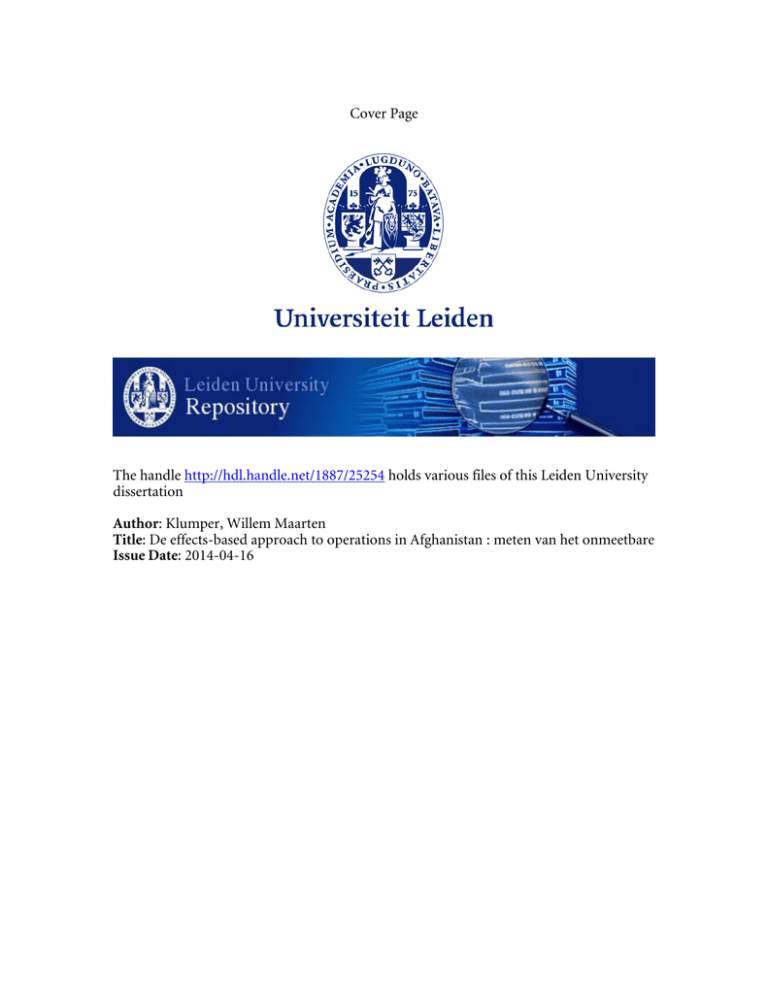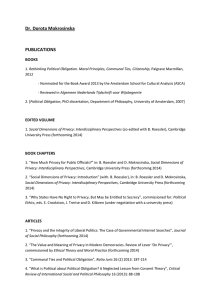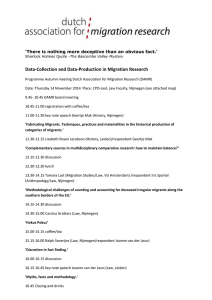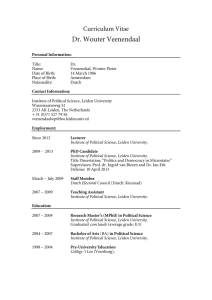Bijlagen
advertisement

Cover Page The handle http://hdl.handle.net/1887/25254 holds various files of this Leiden University dissertation Author: Klumper, Willem Maarten Title: De effects-based approach to operations in Afghanistan : meten van het onmeetbare Issue Date: 2014-04-16 Bijlagen Bijlage 2-1 Verklaring van PMESII-factoren Political Military Economic History of political system. Political processes and culture. Central / Local government. Political interest groups. Regional / Int’l conditions. Influential individuals. Political security. International Organisations. History of military system. Leadership. Armed forces/ORBATS. Internal security. Military industrial complex. Logistics and Sustainment. Opposing forces. Natural assets. Production capabilities. Distribution systems. Consumption. Social Ethno-linguistic groups / Religion. IO/NGOs/DP/Refugee groups. Terrorist / Criminal Organizations. Business associations. Health care / Education. Infra-structure Utilities. Transportation. Industry. Public facilities. Global information. National information. Defence information. Military C2. Info What aspects of the political system affect the current crisis? What aspects of governance are contributing to or mitigating the current crisis? Who are the key nodes in the political system and what are their goals? What are the key relationships of political system elements? What are the objectives of friendly and opposing forces in the current crisis? What are the key military nodes? What are probable courses of action of friendly and opposing forces? What aspects of the economic system affect the current crisis? What are the critical system elements of the economic system? Who wants to use the economic system and for what goal? What aspects of the social system affect the current crisis? How are social groups involved in the current crisis? Relationships between social system elements? What aspects of the infrastructure system affect the current crisis? What are the critical infrastructure system elements and their associated relationships? What aspects of the information system affect the current crisis? Who is trying to use the information systems and for what goals? What are the critical system elements of military C2? PMESII Explanations Bron: Pre Doctrinal Document, p 5 – 3 349 Bijlagen Bijlage 3-1 Interviewprotocol Het interview dient te worden gehouden met officieren die zich binnen de staf bezig houden met EBAO. Dat kan zijn als hoofdbestanddeel van de functie, maar het kan ook zijn dat de respondent in de uitoefening van zijn taken te maken krijgt met EBAO. Het is van belang te benadrukken dat: 1. de analyse van de inhoud van de gesprekken de basis zal zijn voor wetenschappelijke publicatie 2. respondenten niet bij naam genoemd zullen worden, maar een uniek respondentennummer zullen krijgen. 3. de koppeling tussen de naam van de respondent en het respondentennummer alleen bij de onderzoeker bekend is. 4. de respondent geen militair geheime informatie of andere informatie dient te leveren die de lopende operatie zou kunnen beïnvloeden. Voorbereiding en uitvoering: – Zorgen voor een rustige setting waarin het gesprek kan plaatsvinden. – Respondent inlichten over de bedoeling van het onderzoek en aangegeven hoe dit interview daar in past. – Aangeven hoe lang het gesprek kan duren. – Als het de respondenten beter uitkomt, kan worden voorgesteld om meer dan één respondent voor het interview te benaderen. – Interview in principe afnemen van officieren (eventueel ook in het Engels). Hiervoor is de interview-guide nodig. – De interviewer noteert de antwoorden zelf op de guide. – Zo snel mogelijk na het interview de gespreksnotities uitwerken en opnemen in de database. 350 Bijlagen Bijlage 3-2 Interview Guide (lijst met thema’s) Achtergrond – Naam – Functie –Rang – Nationaliteit Knowledge Development – Hoe wordt de benodigde informatie verzameld? – Op welke wijze windt feedback van informatie plaats? – Hoe wordt informatie gedeeld? Plannen – Wat wordt gepland op welk niveau? – Welke planningsactiviteiten zijn specifiek voor de werkomgeving van de respondent? – Welke van die planningsactiviteiten hebben betrekking op EBAO? Assessment – Hoe worden effecten gemeten in werkomgeving van respondent? – In hoeverre wordt hierbij gebruik gemaakt van “harde” data? – In hoeverre wordt hierbij gebruik gemaakt van “zachte” data? – Welke methoden worden nog meer gebruikt? Bijsturen Rol van de nationale politiek – Hoe wordt gestuurd? – Transparantie? Bijsturen van het proces rond EBAO – Wanneer is dat nodig? – Hoe vindt dat plaats? – Welke informatie ligt daaraan ten grondslag? 351 Bijlagen Overig Communicatie – Met welke organisatie-elementen? – Welke inhoud? – Met welke niveaus? – Welke specifieke communicatiemiddelen t.b.v. EBAO? – Hoe wordt gerapporteerd over EBAO? EBAO specifiek – Welke kennis heeft de respondent van doctrines rondom EBAO? – Hoe is de respondent voorbereid op het werken met EBAO? – Welke relatie bestaat er tussen EBAO en het ‘Command and Control’ proces? 352 Bijlagen Bijlage 6-1 Afghanistan National Development Strategy (ANDS). The Afghanistan National Development Strategy was established by the international community as the overall implementing mechanism for post-conflict nation-building in Afghanistan. Despite its name, it is not limited to reconstruction and development, but encompasses all aspects of what is usually referred to as “nation-building”, including governance and security sector reform. The strategic guidance for the ANDS is rooted in the Afghanistan Compact, a high-level political agreement between Afghanistan and the international community, concluded at the London Conference in January 2006. The Afghanistan Compact contains a set of specific benchmarks that need to be achieved by Afghanistan within a set timeframe. The benchmarks are categorized into 3 Pillars – Security, Governance, and Development – and 8 (sub-)sectors. As the main implementation body of the Afghanistan Compact, the ANDS is laid out following the same structure. The ANDS operates through a Secretariat in Kabul. It is Afghan-owned and Afghan-led, albeit with a considerable amount of technical assistance from the international community. The ANDS Secretariat oversees the drafting and review of Ministerial and Sector Strategies at the national level, and supports the establishment of Provincial Development Plans in each province by conducting subnational consultations. A key aspect that is often overlooked is the fact that the full ANDS will serve as Afghanistan Poverty Reduction Strategy Paper (PRSP). As such, it was presented to the World Bank in May 08, to enable the country to obtain HIPC status (Highly Indebted Poor Country) to qualify for debt relief and preferential loan treatment. This process is not unique to Afghanistan. Rather, PRSPs were first introduced by the World Bank and IMF, together with major donor countries, in the mid-nineties. Over 60 third world countries have undergone the PRSP process as a precondition for WB and IMF debt relief since then. The effectiveness of PRSPs in relieving poverty has not been fully proven so far, and the process remains controversial. In particular, the PRSP process prescribes a number of economic measures, such as privatization of state-owned enterprises, cuts in public spending while encouraging private sector development, and currency stabilization, that may – at least initially – have a painful effect on parts of the affected population, e.g. increases in unemployment or rising living costs due to cost-based delivery of services such as electricity or water. While these aspects have proven difficult even in relatively peaceful societies, the ANDS – as ­Afghanistan’s PRSP – is 353 Bijlagen unique in that it is implemented in a conflict environment. Naturally, this makes the ambitious PRSP goals even harder to reach. Bron: “Afghanistan National Development Strategy (ANDS); An Interim Strategy for Security, Governance, Economic Growth & Poverty Reduction”; http://www.ands.gov.af/ands/ ands_guide/ands_guide/The Ands Guide.pdf (benaderd 16 september 2009) 354 Bijlagen Bijlage 6-2 Leden van de adviesgroepen als onderdeel van de Campaign Assessment Board (CAB). CAB – Working Group AAG Director AAG AQO GIRoA Representative UNAMA Representative USAID Representative OAB CHIEF OAB Team (3) LL Chief ACCE CSTC-A SAG Reps (2) RC LNO’s DATES CJ2 (Effect 1 OPR) CJ35 (Effect 2 OPR) STRATCOM (Effect3, 11 OPR) CJ5 CN (Effect 4, OPR) LEGAD (Effect 5, OPR) POLAD (Effect 6, 7 OPR) CJ9 (Effect 8, 9 OPR) Stability Assessment (effect 10 OPR) CIED DEVAD CJ4 CJ5 – Policy & Concepts CJ6 CJMED COMISAF SOF CAB – Council of Colonels AAG Director AAG AQO GIRoA Representative UNAMA Representative USAID Representative OAB Chief OAB Team (3) LL Chief ACCE CSTC-A SAG SAG Deputy DATES CJ2 – Intel Advisor CJ35 – OPLAN Analyst STRATCOM Assessment Chief CJ5 – Chief Plans LEGAD Advisor POLAD – Advisor Chief of Regional Outreach Stability Assessment Chief Chief of Unified Action DEVAD Advisor CJ4 CJ5 – Chief Effects CJ5 – Policy & Concepts Campaign Assessment Board (CAB) COM DCOM (Board Chairman) GIRoA Representative UNAMA Representative USAID Representative COS DCOS Joint Ops DDCOS Joint Ops DD Air Ops CSTC-A SAG DCOS Support DATES CJ2 CJ3 Dir SRATCOM CJ5 Spokesperson POLAD CJ9 DCOS Stability DDCOS Stability DEVAD CJ4 COMISAF SOF AAG Director AAG AQO Bron: SOP 1080, Afghan Assessment Group, Headquarters Security Assistance Force, Kabul Afghanistan, Drafted by Col Claflin, 15 jan 09, p C-2-1. 355



